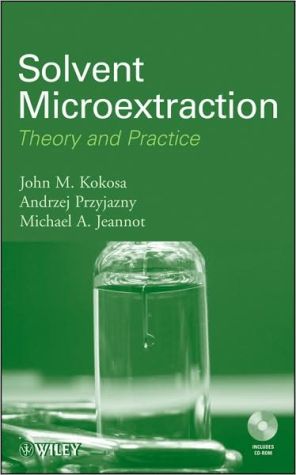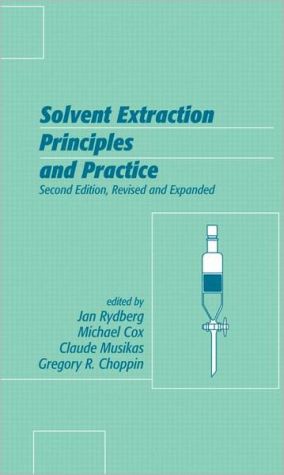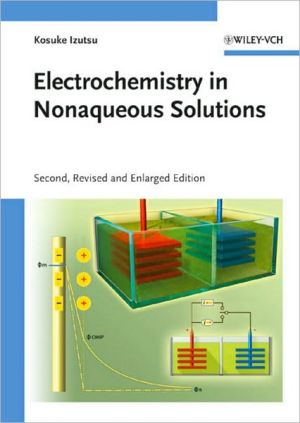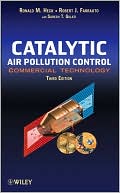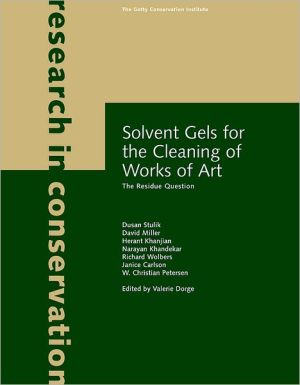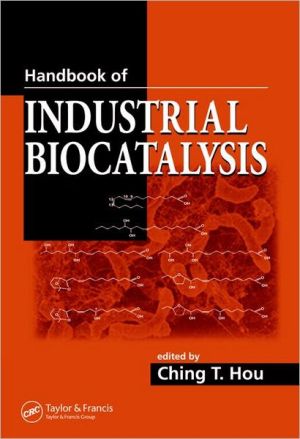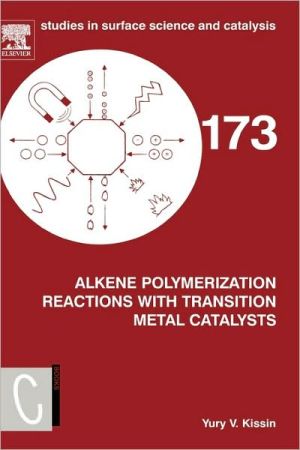Solvent Microextraction: Theory and Practice
This book offers both a practical as well a theoretical approach to Solvent Microextraction (SME) and will help analytical chemists to evaluate SME for a given sample preparation. Introductory chapters overview a comparison of SME with other sample preparation methods, a summary of the technical aspects, and a detailed theoretical treatment of SME. The book then describes the practical aspects of the technique, with detailed “how to” chapters devoted to the preparation and analysis of...
Search in google:
Solvent MicroextractionTheory and PracticeJohn M. KokosaAndrzej PrzyjaznyMichael A. JeannotAdd solvent microextraction to your analytical toolkit with this hands-on guide This timely resource turns solvent microextraction (SME) into a practical analysis tool that analytical chemists will find to be a powerful adjunct to established sample preparation methods. Whether you're involved in sample preparation and analysis of solid, liquid, or atmospheric environmental, clinical, or industrial samples, Solvent Microextraction: Theory and Practice includes the information you need to integrate this cutting-edge sample preparation technique into your everyday practice, including: Insightful comparisons with other popular sampling methodsA theoretical discussion of SME, supported by examples of how theory impacts real samplesAn extensive bibliography of nearly 600 application references, updated to 2009A detailed compilation of experimental parameters and summaries of published procedures to aid in method developmentMore than a dozen experimental procedures for the most commonly used SME modes, with an emphasis on how to effectively apply the technique SME modes classification and glossary to facilitate further study and researchA skill-sharpening CD-ROM that contains summaries of nearly 600 publications using SME Written by the leading experts on SME technology, Solvent Microextraction is a time- and money-saving sourcebook that serves as both a convenient desk reference for the laboratory and an indispensable teaching tool. Most importantly, it goes beyond a compilation of reference material, providing you with a much-needed guide to proper experimental procedures, and a blueprint for understanding how and why the SME technique works.
Preface xiii1 Solvent Microextraction: Comparison With Other Popular Sample Preparation Methods 11.1 Introduction 11.2 Comparison of Sample Preparation Methods 21.2.1 Liquid-Liquid Extraction 31.2.2 Liquid-Solid Extraction 51.2.3 Headspace Extraction 61.2.4 Solid-Phase Microextraction 81.2.5 Solvent Microextraction 91.3 Summary 13References 142 Basic Modes of Operation for Solvent Microextraction 192.1 Basic Principles of SME 192.1.1 Introduction 192.1.2 Comparison of Classical Solvent Extraction and SME 202.2 Extraction Modes 212.2.1 Direct-Immersion Modes 222.2.2 Headspace Modes 302.2.3 Static vs. Dynamic Extraction Modes 312.3 Solvents 322.3.1 General Rules for Choosing a Solvent 322.3.2 Internal and Surrogate Standards 34References 343 Theory Of Solvent Microextraction 373.1 Introduction 373.2 Thermodynamics 373.2.1 Phase Distribution: Fundamental Considerations 373.2.2 Solvation and Solvent Selection 403.2.3 Octanol-Water Partition Coefficients and Henry's Law Constants 413.2.4 Temperature and Salt Effects 413.2.5 Solute Equilibria and Speciation: pH and Back-Extraction 423.2.6 Dissolution and Evaporation of Solvent 443.2.7 Interfacial Adsorption 453.3 Kinetics 463.3.1 Diffusive Mass Transfer and Fick's Laws 463.3.2 Convective-Diffusive Mass Transfer 473.3.3 Two-Phase Kinetics 493.3.4 Three-Phase Kinetics 563.4 Calibration Methods 623.5 Summary 63References 644 Practical Considerations For Using Solvent Microextraction 674.1 Introduction 674.2 General Recommendations 694.3 General Questions to Consider Before Performing an Analysis 704.3.1What Are the Properties of the Chemicals to Be Extracted? 704.3.2 What Type of Sample Matrix Will Be Analyzed? 714.3.3 What Analytical Instrumentation Is Available? 714.3.4 What Is the Concentration of the Analyte? 714.4 Choosing the SME Mode 724.4.1 Direct-Immersion Single-Drop Microextraction 724.4.2 Headspace Extraction 724.4.3 Dynamic Extraction 744.4.4 Hollow Fiber-Protected Microextraction 754.4.5 Dispersive Liquid-Liquid Microextraction 764.5 Extraction Solvent 764.6 Sample Volumes 784.7 Syringe and Microdrop 794.8 Chromatography and Detector Requirements 804.9 Additional Extraction Parameters 804.9.1 Sample Agitation 804.9.2 Ionic Strength 824.9.3 Extraction Temperature and Extraction Time 824.9.4 Chemical Effects 844.10 Calculation Examples for SDME 844.11 Calculation Examples for DLLME and HEME 874.12 Calculation Examples for the Effect of Ionic Strength on SDME 894.13 Calculation Examples for HS-SDME 914.14 Calculation Examples for the Effect of Ionic Strength on HS-SDME 934.15 Calculation Examples for Static Headspace Extraction 954.15.1 Benzene: Static Headspace at Equilibrium 954.15.2 Naphthalene: Static Headspace at Equilibrium 954.15.3 Pyrene: Static Headspace at Equilibrium 964.16 Calculation Examples for Solvent Solubility 97References 985 Method Development In Solvent Microextraction 1015.1 Introduction 1015.2 Extraction Mode Selection 1025.3 Static vs. Dynamic Extraction 1075.4 Selection of Manual vs. Automated Extraction 1085.5 Selection of Direct vs. Derivatization SME 1095.5.1 Preextraction Derivatization 1105.5.2 Concurrent Extraction-Derivatization 1115.5.3 Postextraction Derivatization 1115.6 Extraction Solvent Selection 1135.7 Selection of Final Determination Method 1215.8 Selection of Extraction Optimization Method 1275.9 Optimization of Extraction Conditions 1295.9.1 Optimization of Sample Volume 1295.9.2 Optimization of Headspace Volume 1345.9.3 Optimization of Solvent Volume 1375.9.4 Optimization of Sample Flow Rate 1425.9.5 Optimization of Extraction Time 1425.9.6 Optimization of Sample and Solvent Temperature 1445.9.7 Optimization of pH of Sample and Acceptor Solution 1455.9.8 Optimization of Ionic Strength 1465.9.9 Optimization of Agitation Method and Rate 1475.9.10 Selection of Fiber Type and Length 1485.9.11 Optimization of Dynamic Mode Parameters 1495.9.12 Analytical Characteristics of SME Procedures and Quantitative Analysis 150References 1556 Applications 1696.1 Introduction 1696.2 Gaseous Samples 1716.3 Liquid Samples 1746.4 Solid Samples 1766.5 Environmental Applications of SME 1786.5.1 Volatile Hydrocarbons 1796.5.2 Volatile Halocarbons 1836.5.3 Volatile Polar Solvents 1856.5.4 Nonpolar Semivolatile Compounds 1896.5.5 Polar Semivolatile Compounds 3926.5.6 Metal Ions, Metalloid Ions, and Organometallic Compounds 1966.5.7 Other Inorganic Analytes 1986.5.8 Pesticides 1986.6 Clinical' and Forensic Applications of SME 2046.7 Application of SME in Food and Beverage Analysis 2116.8 Application of SME in the Analysis of Plant Material 2156.9 Application of SME in the Analysis of Consumer Products and Pharmaceuticals 2166.10 Outlook for Future Analytical Applications of SME 2206.11 Physicochemical Applications of SME 2236.11.1 Study of Drug-Protein Binding 2246.11.2 Study of Kinetics of the Partitioning Process 2266.11.3 Study of Mechanistic Aspects of In-Drop Derivatization 2266.11.4 Pharmacokinetic Studies Using SME 2286.11.5 Determination of Octanol-Water Partition Coefficients by SME 229References 2307 SME Experiments 2597.1 Introduction 2597.2 Recommended Experimental Conditions 2617.3 Determination of Gasoline Diluents in Motor Oil by HS-SDME 2647.3.1 Experimental 2667.3.2 Results and Discussion 2667.3.3 Additional Experimental Recommendations 2677.4 Determination of BTEX in Water by HS-SDME 2677.4.1 Experimental 2677.4.2 Results and Discussion 2687.4.3 Additional Experimental Recommendations 2687.5 Analysis of Halogenated Disinfection By-Products by SDME and HS-SDME 2697.5.1 Experimental: HS-SDME 2697.5.2 Experimental: SDME 2707.5.3 Results and Discussion 2707.5.4 Additional Experimental Recommendations 2717.6 Analysis of Volatile Organic Compounds by SDME and HS-SDME 2717.6.1 Experimental: HS-SDME 2727.6.2 Results and Discussion 2727.6.3 Experimental: SDME 2767.6.4 Additional Experimental Recommendations 2767.7 Analysis of Residual Solvents in Drug Products by HS-SDME 2767.7.1 Experimental: Manual HS-SDME 2777.7.2 Results and Conclusions 2777.7.3 Experimental: Automated HS-SME 2777.7.4 Results and Conclusions 2777.7.5 Additional Experimental Recommendations 2817.8 Arson Accelerant Analyses by HS-SDME 2817.8.1 Experimental 2817.8.2 Results and Discussion 2827.8.3 Additional Experimental Recommendations 2847.9 Analysis of PAHs by SDME 2847.9.1 Experimental: SDME Extractions of PAHs from Aqueous Samples 2847.9.2 Results and Conclusions 2857.9.3 Experimental: HS-SDME Extractions of PAHs from Aqueous Solutions 2857.9.4 Results and Conclusions 2867.9.5 Additional Experimental Recommendations 2877.10 Determination of Acetone in Aqueous Solutions by Derivatization HS-SDME 2877.10.1 Experimental 2887.10.2 Results and Conclusions 2887.10.3 Additional Experimental Recommendations 2887.11 Determination of Pesticides in Soil by HF(2)ME 2887.11.1 Experimental 2897.11.2 Results and Discussion 2897.11.3 Additional Experimental Recommendations 2907.12 Determination of PAHs and HOCs by DLLME 2917.12.1 Experimental: Extraction of PAHs from Water 2917.12.2 Experimental: Extraction of HOCs from Water 2917.12.3 Results and Conclusions 2927.12.4 Additional Experiment Recommendations 2927.13 Dynamic Headspace and Direct Immersion Extractions (DY-SME) 2927.13.1 Experimental 2937.13.2 Results and Discussion 2947.13.3 Additional Experimental Recommendations 295References 295Acronyms And Abbreviations 299Appendix SME Modes: Classification And Glossary 303Index 313
\ From the Publisher"The present book constitutes a unique source for the analyst that may find a useful compilation of reference material, a guide to proper experimental procedures, and a better understanding of how and why the technique works." (Chemistry Journals, 11 April 2011)\ "Written by three pioneers and worldwide recognised specialists in the field, this timely monograph is not only an exhaustive and updated compilation of bibliography related to solvent microextration techniques and their applications in different work areas, but a practical and useful guide for all those interested in their direct application to practical case studies." (Chromatographia, 1 December 2010)\ "Describe[s] procedures and applications of the research technique, which in the past dozen or so years has grown beyond academic laboratories to find work in industrial, forensic, clinical, and environmental analysis." (Book News, December 2009)\ \ \
